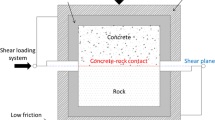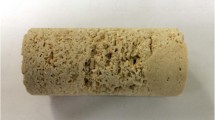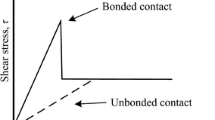Abstract
Shear behaviour of the joints formed by the interface of two different material types, such as rock and cemented paste backfill, rock and concrete or two different rock types, have practical importance in many rock engineering activities. This paper presents the results of an experimental investigation into the shear behaviour of these special joints under pseudo-static shear velocity. Direct shear tests on concrete–plaster interfaces were carried out under boundary conditions of constant normal load and constant normal stiffness. Shearing velocities of the performed tests were in the range of 0.3–30 mm/min. The results of the shear tests conducted on the planar and rough artificial prepared joints showed that the shearing velocity has a significant influence on the shear strength, friction angle and shear stiffness of the hard–soft material interface. So that, these parameters were decreased when shear velocity was increased. Also, comparison of the tests results that performed on the concrete–plaster joints with those from tests on the plaster–plaster and concrete–concrete interfaces showed that the shear behaviour of concrete–plaster interface is governed mainly by the shear parameters of the plaster block (namely softer material).



















Similar content being viewed by others
References
Armand G (2000) Contribution a la caracterisation en laboratoire et a la modelisation constitutive du comportement mecanique des joints rocheux. PhD Thesis, University Joseph Fourier, Grenoble
Barla G, Barbero M, Scavia C, Zauinetti A (1990) Direct shear testing of single joints under dynamic loading. In: Barton N, Stphansson O (eds) Rock joints. A. A. Balkema, Rotterdam, pp 447–454
Barton N (1973) Review of a new shear strength criterion for rock joints. Eng Geol 7:287–332
Boulon M (1995) A 3D direct shear device for testing the mechanical behaviour and the hydraulic conductivity of rock joints. In Rossmanith P (ed) Proceedings of mechanics of jointed and faulted rock, pp 407–413
Brackebusch FW (1994) Basics of paste backfill systems. Min Eng 46:1175–1178
Crawford AM, Curran JH (1981) The influence of shearing velocity on the frictional resistance of rock discontinuities. Int J Rock Mech Min Sci Geomech Abstr 18:505–515
Cuisiat FDE, Hyett AJ, Hudson JA (1990) Numerical investigation of the boundary conditions effect on rock joint behaviour. In: Barton N, Stephannsson O (eds) Proceedings of the international conference on rock joints. Taylor & Francis, Loen, pp 611–616
Fall M, Benzaazoua M (2005) Modeling the effect of sulphate on strength development of paste backfill and binder mixture optimization. J Cem Concr Res 35(2):301–314
Fall M, Benzaazoua M, Ouellet S (2005) Experimental characterization of the influence of tailings fineness and density on the quality of cemented paste backfill. Min Eng 18:41–44
Fall M, Belem T, Samb S, Benzaazoua M (2007a) Experimental characterization of the stress–strain behaviour of cemented paste backfill in compression. J Mater Sci 42(11):3914–3992
Fall M, Benzaazoua M, Sae E (2007b) Mix proportioning of underground cemented paste backfill. Int J Tunn Undergr Constr 23:80–90
Ghazvinian AH, Taghichian A, Hashemi M, Mar’ashi SA (2010) The shear behaviour of bedding planes of weakness between two different rock types with high strength difference. Rock Mech Rock Eng 43:69–87
Grasselli G, Egger P (2003) Constitutive law for the shear strength of rock joints based on three-dimensional surface parameters. Int J Rock Mech Min Sci 40:25–40
Haberfield CM, Johnston IW (1994) A mechanistically-based model for rough rock joint. Int J Rock Mech Min Sci Geomech Abstr 31:279–292
Haberfield CM, Seidel JP (1999) Some recent advances in the modeling of soft rock joints in direct shear. Geotech Geol Eng 17:177–195
Helinski M, Fourie AB, Fahey M (2006) Mechanics of early age cemented paste backfill. In: Jewell RJ, Lawson S, Newman P (eds) Proceedings 9th international seminar on paste and thickened tailings. Australian Centre of Geomechanics, Ireland, pp 313–322
Huang TH, Doong YS (1990) Anisotropic shear strength of rock joints. In: Barton N, Stephansson O (eds) Proceedings of rock joints. Taylor & Francis, Loen, pp 211–218
Hutson RW, Dowding CH (1990) Joint asperity degradation during cyclic shear. Int J Rock Mech Min Sci Geomech Abstr 27(2):109–119
Indraratna B (1990) Development and applications of a synthetic material to simulate soft sedimentary rocks. Geotechnique 40(2):189–200
Indraratna B, Haque A (2000) Shear behaviour of rock joints. Balkema Publishers, Rotterdam, p 164. ISBN:90 5809 3077
Jafari MK, Hosseini K, Pellet F, Boulon M, Buzzi O (2003) Evaluation of shear strength of rock joints subjected to cyclic loading. Soil Dyn Earthq Eng 23:619–630
Jafari MK, Pellet F, Boulon M, Hosseini K (2004) Experimental Study of Mechanical Behaviour of Rock Joints Under Cyclic Loading. Rock Mech Rock Engng 37(1):3–23
Jiang Y, Xiao J, Tanabashi Y, Mizokami T (2004) Development of an automated servo-controlled direct shear apparatus applying a constant normal stiffness condition. Int J Rock Mech Min Sci 41:275–286
Johnston IW, Lam TSK (1984) Frictional characteristics of planar concrete–rock interfaces under constant normal stiffness conditions. In: Proceedings of the 4th ANZ conference on geomechanics, vol 2, Perth, pp 105–108
Johnston IW, Lam TSK (1989) Shear behaviour of regular triangular concrete/rock joints–analysis. J Geotech Eng Div ASCE 115:711–727
Kesimal A, Ercikdi B, Yilmaz E (2003) The effect of desliming by sedimentation on paste backfill performance. J Min Eng 16:1009–1011
Kodikara JK, Johnston IW (1994) Shear behaviour of irregular triangular rock–concrete joints. Int J Rock Mech Min Sci 31(4):313–322
Kusumi H, Nishda K, Teraoka K (1998) A formulation of shear strength for rock joints included two or three different asperities. In: Rossmanith P (ed) Proceedings of mechanics of jointed and faulted rock, pp 235–239
Ladanyi B, Archambault G (1977) Shear strength and deformability of filled indented joints. In: international symposium the geotechnics of structurally complex formations, Capri, pp 317–326
Lam TSK, Johnston W (1989) Shear behaviour of regular triangular concrete/rock joints Evaluation. J Geotech Eng Dir ASCE 115:728–740
Landriault D (1992) INCO’s backfill experience. Can Min J 113:39–46
Maksimovic M (1996) The shear strength components of a rough rock joint. Int J Rock Mech Min Sci Geomech Abstr 33:185–200
Mostyn GR, Bagheripour MH (1998) A new model material to simulate rock. In: Rossmanith P (ed) Proceedings of mechanics of jointed and faulted rock, pp 225–230
Nasir O, Fall M (2008) Shear behaviour of cemented pastefill-rock interfaces. Eng Geol 101:146–153
Patton FD (1966) Multiple modes of shear failure in rock. In: Proceedings of the 1st congress of ISRM, Laborato rio nacional de engenharia civil, Lisboa, vol 1. pp 509–513
Saeb S (1990) A variance on the Ladanyi and Archambault’s shear strength criterion. Rock Joint:701–705
Seidel JP, Haberfield CM (2002) A theoretical model for rock joint subjected to constant normal stiffness direct shear. Int J Rock Mech Min Sci Geomech Abstr 39:539–553
Sivakugan N, Rankine RM, Rankine KJ, Rankine KS (2006) Geotechnical considerations in mine backfilling in Australia. J Clean Prod 4(12–13):1168–1175
Stimpson B (1970) Modelling material for engineering rock mechanics. Int J Rock Mech Min Sci 7:71–121
Williams TJ, Denton DK, Larson MK, Rains RL, Seymour JB, Tesarik DR (2001) Geomechanics of reinforced cemented backfill in an underground stope at the Lucky Friday Mine. Rep Investig 9655:24
Yilmaz E, Kesimal A, Ercidi B (2004) Strength development of paste backfill simples at long term using different binders. In: Proceedings of 8th symposium MineFill04, China, pp 281–285
Author information
Authors and Affiliations
Corresponding author
Rights and permissions
About this article
Cite this article
Atapour, H., Moosavi, M. Some Effects of Shearing Velocity on the Shear Stress-Deformation Behaviour of Hard–Soft Artificial Material Interfaces. Geotech Geol Eng 31, 1603–1615 (2013). https://doi.org/10.1007/s10706-013-9687-6
Received:
Accepted:
Published:
Issue Date:
DOI: https://doi.org/10.1007/s10706-013-9687-6




